Montessori Pathways' News
February 2011
Notes from Miss Alena
The harsh winter season is finally coming to an end and as we look outside the windows, we earnestly await the warm spring days.
We would like to thank Daniel Wagler for making the amazing “snow maze” in our backyard after big snowfall. The kids really loved playing different games in it and making sled hills from the extra snow. Thank you Daniel!

We’re very thankful to the parents who attended our
Language Parent Meeting despite the cold and wintery weather. Ms. Jocelyn introduced parents to materials that help develop speech and language skills in a Montessori classroom,
which can actually be found in all areas of the classroom (math, science, practical life, etc). She also pointed out that the development of language starts at the earliest stages of life and every interaction with the child is a chance to further enhance language abilities. At the meeting, we discussed what activities parents can implement at home to further help their children develop these skills.
Please mark your calendars!
I would like to invite everyone to our next parent meeting, the Montessori Kindergarten Explained: the Importance of the Third Year, led by Ms. Jocelyn and Ms. Karen on Wednesday, March 9th at 7:00 pm.
I earnestly encourage all parents of uprising kindergarteners to attend this meeting. I ask that parents come prepared with all questions and concerns to ensure that our time together is most productive and helps clarify all of your uncertainties.
We plan to host a Family Friday Night, Be a Montessori Student, on April 15th at 6:00 pm (so don’t leave your taxes for that day!
Throughout the year, we held various meetings discussing developmental activities in the different Montessori areas. Now is your chance to experience the Montessori work cycle in its entirety: jump into your child’s shoes and within a couple of hours, work with different materials in a variety of areas with presentations from our teachers to guide you. The work cycle, as usual, will conclude with line time, preparation for dinner and, of course, the dinner itself, allowing you to experience the lunch routine that occurs each day.
I even invite you to provoke various situations that might occur between students throughout the day (teasing, restlessness, etc). Make it a real classroom situation (just don’t go overboard) and live through the grace and courtesy lessons your children learn by overcoming such issues. You are welcome to attend with your children.
We would like to announce that enrollment/re-enrollment for the 2011-2012 School Year, as well as for Summer Camp, begins in March.
Plans for class sizes, school environment, staff and enrichment programs require intensive care and, most importantly, time. To ensure that the school is at its best in time for the next school year, we encourage parents planning to continue in the Montessori Pathways family to begin registering now.
If you would like to lock in this year’s prices for the next school year (as we are planning to review and raise prices to accommodate the national price increases), you can register by June 1st and guarantee that your payments will remain the same.
We also offer you a chance to waive the re-enrollment registration fee by registering at one of our Saturday Open Houses (March 19th, April 16th and May 14th) 11:00am-2:00pm, where you will also have a chance to calmly discuss all questions and concerns regarding the upcoming Summer Camp and school year.
We sincerely hope everyone’s fully recovered and await refreshing warm spring days to bring about new energy for us all!
Warmly,
Miss Alena
Notes from the classroom:
Miss Jocelyn and Miss Christine

February is always a fun month in the classroom because nearly every week has a special day to celebrate. We began with Groundhog’s Day on the 2nd, which helped to culminate our work about animals in winter by focusing on the hibernation of an important groundhog named Punxsutawney Phil.

Despite the fact that Groundhog’s Day ended up being a snow day, many of the children returned the following day to tell us that Phil did not see his shadow and predicted an early spring. (We are really hoping he is right!)
Next up was Valentine’s Day, a day in which all members of our community show their gratitude and appreciate of friendship for all.
One at a time each child passed out the valentine cards or goodies they brought to each of their school friends. It was wonderful to see each child practice grace and courtesy to one another by saying “thank you” as each child’s container slowly but surely filled up!

In the spirit of togetherness, we shared group snack in the morning of fresh cucumber slices to counter balance the inevitable consumption of candy later in the day! Also, for several weeks, special Valentine themed works were available on the shelves: Sorting Valentine hearts, opening and closing 2 piece heart containers and fine motor stringing of Valentine heart beads were favorites. Some children created beautiful “stained glass” windows using shaved crayons which we melted with an iron to replicate a beautiful mirage of colors.
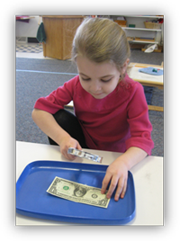
Finally, February rounded out with
President’s Day, focusing on an introduction to George Washington and Abraham Lincoln. For very young children, the works focus on meaningful objects, which in this case are the dollar bill for Washington and the penny for Lincoln. The purpose is to create awareness and hopefully spark an interest in a child to learn more when they are ready. Two favorite activities included using a magnifying glass to look at details on a dollar bill and filling and emptying pennies into a piggy bank to work on fine motor, dexterity and counting.

In the
Language area, a new work extending activities related to these holidays was the introduction of “February Words”. This work features a collection of words that specifically relate to the month of February. The words help children practice word recognition skills and build their vocabulary in a timely and meaningful way.
For example, some of the February words included shadow, burrow and groundhog; heart, envelope and candy; president, Washington and teeth (which led to fun conversations about wooden teeth and proper tooth brushing!)
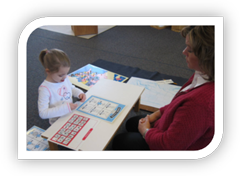
For the children who are reading, the monthly words give them an opportunity to sort the set of words into words that go together and “read” longer and more complex words. Many of our Kindergarteners also used these words to practice sentence building and book making. For children who are not yet reading, they enjoyed gathering around to listen to their friends read and to hear more about each word.
Thank you to all of our families who provided wonderful fresh fruits and vegetables for our
food prep and tasting activities this month. We made homemade muffins; the children really enjoyed our tasting activity that compared the citrus fruits of navel oranges and ruby red grapefruit.
Most children had never tried grapefruit, but nearly all liked it! Also, they all enjoyed learning the vocabulary associated with the tasting activity such as peel, rind, pith, flesh and citrus and comparing sweet and sour. They discovered that grapefruit flesh is really sweet, but the pith is sour.
Our classroom has developed many responsible and diligent helpers; each day brings laundry to fold, silverware to sort and put away, tables to set for lunch, food to prepare/cut, dishwashing, and preparation for our community lunch. Invite your child to help with these daily tasks in your house – they seem to take such pleasure in contributing to the operation of our classroom and are quite adept at tasks you’ d be amazed at observing!

Hopefully more cooperative weather will abound so please keep in mind waterproof gloves, snowpants and boots along with extra clothes to change into when we’re outside and things get wet.
Looking ahead to March, spring parent conferences for the children in our class will be held Monday, March 14th- Wednesday March 16th. The sign-up sheet is located in the front entry way of the school, so please stop in and sign up for a time that will work best for you. We look forward to meeting with you soon!
Miss Jocelyn and Miss Christine
Notes from the classroom:
Miss Karen and Miss Ambreen
Mathematical Thinking
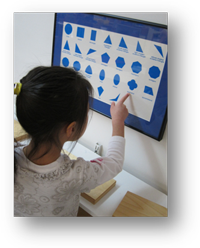
Current research provides stronger evidence than ever that without language, math doesn’t exist. The strength of the Montessori math approach is not simply that it teaches the mathematical language necessary, but that it provides meaning for that language through beautiful, concrete, hands-on experiences with specially designed materials. New studies show that language is foundational for UNDERSTANDING math concepts. We have to actively teach specific language. Without language, children do not “just get it”. (See “Off the Shelf”).
“Off the Shelf”
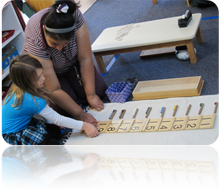
There are 2 specific activities which illustrate the point made in mathematical thinking. One is called the Teen board and one is called the Tens board. The Teen board illustrates the composition of numbers 11 – 19. The Tens board illustrates the composition of numbers 11 – 99.
The eventual point of each is to compose, with actual ten bars and unit bars, 2 place value numbers. Place value is frequently a stumbling block, a topic that many children struggle with well beyond the early elementary years.
However, since Montessori has materials to actually make the numbers with “tens” and �����ones”, the child can get an experiential sense of place value as they create number and quantity.
Like many lessons in Montessori, the Teen board and Tens board activities have several component steps.
There is a three step pattern:
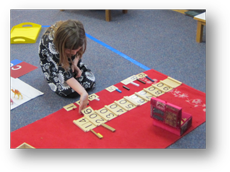
First step: the child simply uses the concrete materials (no numeral representation) to create numbers. They can actually do this without counting (i.e. 10 bar + 6 bar = 16) or (3 ten bars + 4 bar = 34). Then they can verify by counting what they have created.
It is the NAME of the number that is the “glue” between the number and the quantity.
Second step: we introduce the numeral (the symbol or representation of the quantity). The children simply compose and read numbers using special cards which stack up and show place value, another aid to learning.
Finally, the third step: the children associate the quantity and the numeral (a symbol). It is a well thought out strategy which is applied frequently in teaching particular mathematical ideas. Nowhere is it more useful that in working with place value.
Interesting
98% of kindergartners score extremely high on divergent thinking. 2% of adults score extremely high on divergent thinking. What happened??
Our special songs in honor of St. Patrick’s Day are:
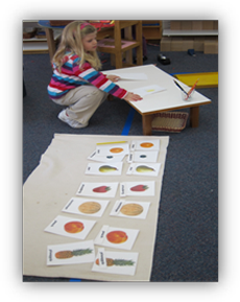
Sung to “Eensy Weensy Spider”
An eensy, weensy leprechaun
Came out St. Patrick’s Day
To look for the gold
That was hidden far away.
Over the rainbow
Was where he was told,
So, with a wink of his green eye,
He ran to get the gold.
Sung to: “I’m a Little Teapot”
I’m a little leprechaun
Dressed in green.
The tiniest man
That you have ever seen
If you ever catch me, so it’s told,
I’ll give you my big pot of gold
Our author of the month is: Leo Lionni
Leo Lionni is credited, not only with his own well-loved books, but with being a primary inspiration for two other favorite children’s authors: Ezra Jack Keats and Eric Carle.
Adults are attracted to Lionni’s books through his art, but what about the children? Among his many gifts was his ability to understand how the child’s mind works. He knew that children respond to and identify with stories about animals. And so the stories that he created are simple fables, using the animals to show a human value. The stories are primarily entertaining, but most children come away with a new understanding of sharing, cooperating, individuality, peace and other underlying meanings of the tales.
Leo is a kind of 20th century Aesop who opened the doors of children’s books to the best that modern art and design has to offer. He has received numerous awards including four Caldecott Honor Book Silver Medals.
Taking It Home
Give the social reason for rules rather than flat authority: “Hang up the coat before the baby steps on it and wrinkles it.” rather than “Hang it up!”
Give awareness of the consequences: “Hitting hurts Peter.” rather than simply “Don’t hit Peter.”
Recognize the validity of emotions when you limit destructive actions: “I know you are angry, but you may not hurt Mary” rather than “Why did you hit Mary, she is your friend?”
“I know you are afraid, but you must have the scratch cleaned to prevent infection.” rather than: “You are a big girl and that little scratch doesn’t hurt.”
“I know you don’t want to wear your shoes, but you must protect your feet when you walk on the city sidewalks.” rather than: “You don’t want your feet to get all dirty and hurt, do you?”
“…we discovered that education is a natural process which develops spontaneously in the human being. It is not acquired by just listening to words, but through experiences in which the child ACTS ON HIS ENVIRONMENT.”
Maria Montessori
Miss Karen and Miss Ambreen
Kindergarten Extended Day
Curriculum
We have loved listening to Aesop’s Fables. The children are glued to those stories and several times a week, we have a chance to squeeze one in. We have a collection of about 20 of the fables, so in addition to such well-known fables as The Boy Who Cried Wolf, we have enjoyed How the Tortoise Got Its Shell and, most recently, The Country Mouse and the Town mouse.
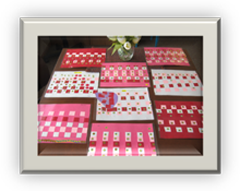
There were several highlights this month including Valentine’s Day. This holiday ranks second only to Christmas for the children. So we enjoyed making cards for the parents and woven placemats. It was a chance for expression of creativity mixed with love for mom and dad.
We also talked about Abraham Lincoln with emphasis on how different life was at that time. For example, as a young child, you would be expected to do many chores: carry water from the creek, gather kindling, sweep ashes out of the fireplace, help in the garden, etc. For fun, their book included a crossword puzzle, a maze, and the silhouette of Lincoln.

We began
the time line of the development of complexity of life on earth. Through this project, we will see that life developed from the simple (one cell) to the very complex. We will look at similarities and differences in animals and follow the categories of animal classification: invertebrates and vertebrates, then the groups of vertebrates: fish, amphibians, reptiles, birds, and mammals. Through looking at fossils, we will see that some animal life has become extinct. In the end, the product will be the child’s representation of the development of life.

The field trip to Petsmart was a great introduction for us since Eric focused on the above categories and we saw and/or handled species from each category. We could pet a snake, watch a hermit crab scurry across the floor, hold a worm, pet the guinea pig, and much more. Eric was so good at answering the children’s insightful questions. Thank you to Scott Cain who was the parent driver for the trip.
Our Recent Science Experiment
I would like to highlight our most recent science experiment and show the richness of one simple activity.
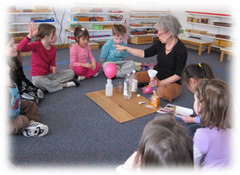
We prepared by reading the list of materials and assembling the equipment we needed, then double checked that we had everything necessary. These were simple materials that you all have at home, so your child can demonstrate our experiment for the family. We needed: vinegar, baking soda, an empty soda bottle, a funnel, a teaspoon, and a balloon.
After preparation, we read the directions step by step (sequencing in a practical way).
We followed each direction. Some steps intentionally had a “problem” to solve. The directions called for a teaspoon. I had changed to a ½ teaspoon. Several children recognized that we could use two ½ teaspoons to make a whole teaspoon. Then directions asked for 2 teaspoons. That involved a new calculation: we now needed four ½ teaspoons. Of course, it took off from there.
There was a lesson in accurately measuring dry ingredients: the need to even off the top of the baking soda spoon, in this case, using the rim of the box. This measuring technique can, of course, be applied to flour sugar, baking powder, and all dry ingredients.
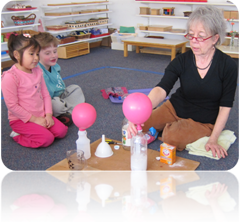
We measured the vinegar (1/3 cup) and talked about that.
Then there was the combining of the ingredients which cause a gas (carbon dioxide) to be produced and inflate the balloon that had been placed over the soda bottle.
We decided to really experiment and change the amount of ingredients to see if it would change the result. That really was an experiment as we simply did not know although the children were eager to predict. Mr. Alex was invited to come and participate with us.
Then someone wondered if it would work with the “old” vinegar that had been previously combined with the baking soda. Would it still work? Let’s try.
Finally, the children wanted to taste the baking soda. Who would have thought? Most of them actually liked it!
So, in one simple science experiment:
calculation, measuring, prediction, changing the “recipe” of the experiment, observation, taking turns, new vocabulary, and tasting! And fun!! We have left the inflated balloons on the soda bottles to see if they are still inflated when we return on Monday.
Artist of the Month
We will continue with
Marc Chagall. We are delighted to have Miss Terri back working with our Kindergarteners after her leave at her mother’s passing. We have plans for a mosaic production and possibly an activity replicating a stained glass look.
Mathematical Thinking

Now, at this time of the year, we are seeing applications of mathematical thinking so often in so many circumstances. Sometimes it is simply setting the table ---children, on their own, figuring out how many place settings we need, how many children are absent, etc. Sometimes it is the expression “Oh that’s so easy!!!!” to problems and equations that were not internalized just a few short months ago. Sometimes it is seeing PATTERNS and RELATIONSHIPS that exist in math ---- foundational for an understanding and love of math. It is blossoming all around us.
Miss Karen
Notes from the classroom:
Miss Terri and Miss Donna

Even though February is a short month, it was a busy one in the afternoon class. We had many art projects but the most popular, of course, was for Valentine’s Day. The afternoon class had a special, secret mission for the day. They were to make Valentine’s for the teachers, Ms. Alena and Mr. Alex. All kinds of cutting and gluing and stickers were involved. The children were given lace doilies which contained hidden rosebuds and hearts in the lace which they cut out and glued (sometimes in layers) onto their folded construction paper card. We practiced our folding, corner to corner, and made a good crease with a pencil on the folded edge. We then wrote a message on the inside after adding many heart foam stickers. We surprised the teachers with our special delivery.
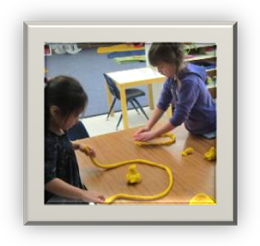
We also made more play dough this month – yellow this time. Some of the new children had never handled warm, homemade play dough before. They had lots of experts to show them how to knead the dough and make assorted animals, pancakes and pizzas. We also made clay snowmen after reading the book, Hello Snow. The children practiced rolling balls of assorted sizes to make snowmen bodies and then decorated them with buttons, hats, earmuffs, arms and scarves all made out of clay in assorted colors. Once the children are shown how to make a few simple shapes they want to make all kinds of creatures and objects. Stimulating their imagination and creativity is the key! Their hands and fingers are getting stronger as they are creating.

Another fun project this month was making our own puzzles. A parent donated copies of dinosaur characters playing sports. We colored the pictures first with crayons – our challenge was to cover every square inch. Then, Ms. Terri glued our pictures onto cardstock paper (done with spray adhesive, outside away from the children). We then turned our picture over and drew puzzle shapes on the back and then cut them out. It was a lot of fun putting our own dinosaur puzzles back together again.
We finished reading The Little House on the Prairie book - the Ingalls family was once again moving away from Indian Territory. In this book Laura finally gets to see a papoose as the Indians passed by and she was so sad that she cried and cried because Ma said she could not have a papoose of her own. Our newest chapter book is Farmer Boy, the next book in the series. Almanzo (Laura’s future husband) is the main character. The story is told through his eyes as we learn what hard workers pioneer boys were. He rises before the sun comes up in the freezing cold to do chores before school and chores again after school (i.e. feeding the calves, cleaning out stalls, milking the cows and fetching wood). Life was very hard work and everyone did their share. We’ve almost finished Charlotte’s Web and we will be doing an art project as we finish up the book.
We also reread a favorite – The Girl Who Danced with the Dolphins. It is a book Ms. Terri received from her mom gave after her mother swam with the dolphins while she was living in Florida. It is a beautiful book about a little girl who is saved from sharks by a dolphin.
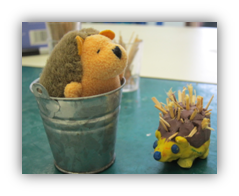
Our last art project/book involved a hedgehog from a book called Ouch. We made our own hedgehogs out of clay. We did not have brown clay so we had to mix our own with lots of yellow,
some red and a little bit of blue. It was very hard at first to mix the clay but it softened as we twisted and smashed it with our warm hands.
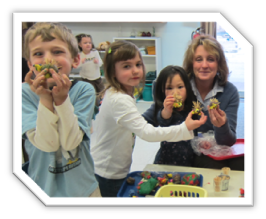
It was a lot of work but we persevered and made lots of shades of brown clay! We made little hedgehog bodies with legs and ears and noses and for spines with added broken toothpick pieces. They turned out great.
Apple sauce prepared by kids has been a big hit this month for snack. We each take turns washing, coring, slicing and chopping the apples. Chopped apples are put in an electric fry pan with cinnamon and water to simmer until tender (usually takes a couple of hours) then we let the chunky apple sauce cool before we put it into a grinder. Then, we took turns turning the crank to make creamy apple sauce. We’ve also made cupcakes, bran muffins, banana bread and corn bread this month. We served either apple slices, orange slices, grapes or cuties along with the crackers or breads. Here is our delicious, famous banana bread recipe:
2 c. flour
1t. baking soda
½ t. salt
½ c. butter
1 c. sugar
2 eggs
1 c. (two mashed) ripe bananas
1/3 c. milk
1 t. lemon juice
Mix dry ingredients
Cream butter, add sugar and mix until combined
Add bananas and eggs – blend thoroughly
Combine milk and lemon juice
Alternate adding dry ingredients and milk/lemon to banana mixture
Grease 9x5 bread pan
Bake at 350 for 60-70 minutes
Hope you enjoy it as much as we do!
Gym Class with Ms. Donna

We began this month with a Groundhog Day game. Locomotor movements were performed and when the children heard no shadow they would jump into their home (a hula hoop) and go back to sleep.
A parachute was used to move beanbags around. The children would sit with their legs under the parachute and use their arms to make waves with the parachute to move the bean bag to a certain color.
A drum was used to help us in making our locomotor movements go fast, slow or steady. Yes, the speed they liked the best was fast.
We played a matching heart game. Each child had half of a paper heart and they had to find out who had their missing half.

Airport is another popular game. The room has four different airports. When “find an airport is announced" the students land at an airport and must balance on one leg. They also enjoyed flying high and low.
The "Mulberry Bush" game had us ducking down behind mats on the word duck.
Scarves were fun as we tossed and caught them. We used our dominant hand and our non-dominant hand for catching the scarves. We tried tossing the scarf and rubbing your tummy before you caught your scarf. Then we tried tossing the scarf and turning around before catching the scarf.
We tossed a bean bag up into the air and tried to catch it before it touched the ground. The students are learning not to toss as high as they in order for them to have a better chance at catching the bean bag. They also practiced tossing and catching a bean bag with a partner. This is a lot easier said than done.
Miss Terri and Miss Donna
